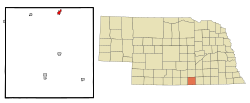Blue Hill, Nebraska
| Blue Hill, Nebraska | |
|---|---|
| City | |

Downtown Blue Hill: north side of West Gage Street
|
|
 Location of Blue Hill, Nebraska |
|
| Coordinates: 40°19′52″N 98°27′0″W / 40.33111°N 98.45000°WCoordinates: 40°19′52″N 98°27′0″W / 40.33111°N 98.45000°W | |
| Country | United States |
| State | Nebraska |
| County | Webster |
| Area | |
| • Total | 0.73 sq mi (1.89 km2) |
| • Land | 0.73 sq mi (1.89 km2) |
| • Water | 0 sq mi (0 km2) |
| Elevation | 1,975 ft (602 m) |
| Population (2010) | |
| • Total | 936 |
| • Estimate (2012) | 916 |
| • Density | 1,282.2/sq mi (495.1/km2) |
| Time zone | Central (CST) (UTC-6) |
| • Summer (DST) | CDT (UTC-5) |
| ZIP code | 68930 |
| Area code(s) | 402 |
| FIPS code | 31-05560 |
| GNIS feature ID | 0827502 |
| Website | http://bluehillne.com/ |
Blue Hill is a city in Webster County, Nebraska, United States. The population was 936 at the 2010 census.
Blue Hill was originally called Belmont, and under the latter name was platted in 1878 when the Burlington and Missouri River Railroad was extended to that point. When it was discovered that another Belmont in the state existed, the name was changed to Blue Hill. The present name alludes to the nearby Blue River.
Blue Hill is located at 40°19′52″N 98°27′0″W / 40.33111°N 98.45000°W (40.331008, -98.449967).
According to the United States Census Bureau, the city has a total area of 0.73 square miles (1.89 km2), all of it land. Blue Hill is situated at 22.5 miles north of the Nebraska-Kansas state line and is 150 miles west of the Missouri River.
Blue Hill's local government consists of one mayor and five board members who hold meetings on the second Tuesday of every month. As of January 2011, the mayor is Keri Schunk.
As of the census of 2010, there were 936 people, 363 households, and 228 families residing in the city. The population density was 1,282.2 inhabitants per square mile (495.1/km2). There were 392 housing units at an average density of 537.0 per square mile (207.3/km2). The racial makeup of the city was 97.4% White, 0.6% African American, 0.1% Native American, 0.2% Asian, 0.1% Pacific Islander, 0.1% from other races, and 1.4% from two or more races. Hispanic or Latino of any race were 1.8% of the population.
...
Wikipedia
